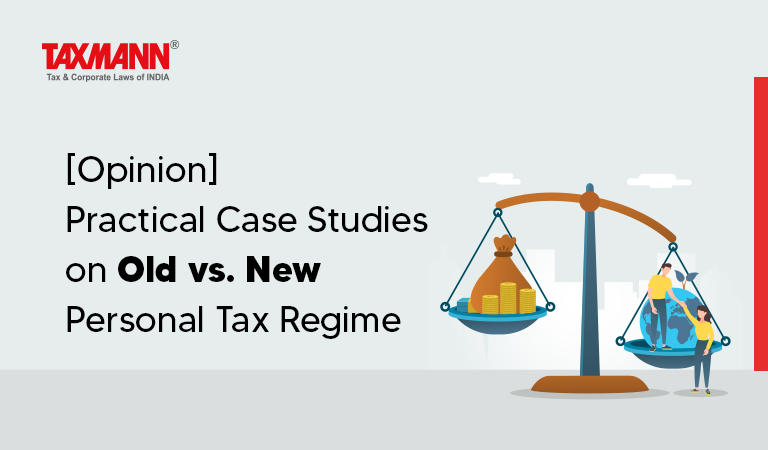[Opinion] Practical Case Studies on Old vs. New Personal Tax Regime
- Blog|News|Income Tax|
- 2 Min Read
- By Taxmann
- |
- Last Updated on 9 March, 2023

Mayank Mohanka – [2023] 148 taxmann.com 104 (Article)
Among the total 122 tax laws amendments proposed in the Union Budget 2023, five budget announcements in respect of Personal Taxation have garnered the majority of the attention and traction from all quarters and why not, as these amendments have a direct bearing on all of us- the hard-working Middle Class.
In her Budget Speech also, our hon’ble FM Smt. Nirmala Sitharaman has said,
“Now, I come to what everyone is waiting for — personal income tax. I have five major announcements to make in this regard. These primarily benefit our hard-working middle class.”
Among these five major personal tax related budget announcements also, the four announcements concentrate on making the new personal tax regime more appealing and attractive to the taxpayers, in comparison to the old personal tax regime.
Our hon’ble CBDT Chairman, in a recent interview has said that the Budget 2023 has sweetened the new personal tax regime. Well, indeed the new regime has been sweetened, w.e.f. FY 2023-23 and onwards, with the reduced tax slab rates, increase in the basic exemption limit from Rs. 2.5. lakhs to Rs. 3 lakhs, increase in the threshold income limit of rebate from the existing Rs. 5 lakhs to Rs. 7 lakhs u/s 87A and the reduction in surcharge rate from 37% to 25% for HNI’s having annual income exceeding Rs. 5 crores. But whether these sweeteners are enough to encourage the taxpayers to switch to the new regime from the old regime, is a million-dollar question.
Friends, in this Article, I am trying to answer this million-dollar question only, but not in some abstract or vague terms, but by way of my in-depth ‘break-even point analysis’ and practical case studies, relevant to professionals, proprietor businessmen and the salaried class.
Break Even Point Analysis
Post Budget 2023 announcements, the salaried class, the businessmen and the professionals are confronted with a tough choice between the old regime with available deductions and the new regime with tax slab rates reduction.
They are faced with an intriguing question, i.e., whether the amount of Gross Tax Payable to be filled by them at serial no. 3 of Part B of TTI Schedule, in their respective Income Tax Returns (ITRs) Forms, will get reduced by claiming and filling in the figures of deductions in Schedule VIA of their ITR Forms, or by leaving the said Schedule VIA blank.
The most practical, logical and authentic way to make this choice easier for them, is to work out the exact amount of specified deductions which are required to be claimed by them in the old regime, at different levels of income, to break-even with the reduced tax liability in the new personal tax regime.
Click Here To Read The Full Article
Disclaimer: The content/information published on the website is only for general information of the user and shall not be construed as legal advice. While the Taxmann has exercised reasonable efforts to ensure the veracity of information/content published, Taxmann shall be under no liability in any manner whatsoever for incorrect information, if any.

Taxmann Publications has a dedicated in-house Research & Editorial Team. This team consists of a team of Chartered Accountants, Company Secretaries, and Lawyers. This team works under the guidance and supervision of editor-in-chief Mr Rakesh Bhargava.
The Research and Editorial Team is responsible for developing reliable and accurate content for the readers. The team follows the six-sigma approach to achieve the benchmark of zero error in its publications and research platforms. The team ensures that the following publication guidelines are thoroughly followed while developing the content:
- The statutory material is obtained only from the authorized and reliable sources
- All the latest developments in the judicial and legislative fields are covered
- Prepare the analytical write-ups on current, controversial, and important issues to help the readers to understand the concept and its implications
- Every content published by Taxmann is complete, accurate and lucid
- All evidence-based statements are supported with proper reference to Section, Circular No., Notification No. or citations
- The golden rules of grammar, style and consistency are thoroughly followed
- Font and size that’s easy to read and remain consistent across all imprint and digital publications are applied




